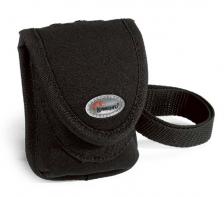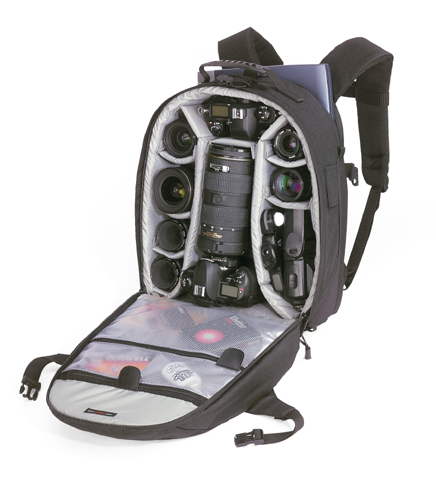How do you choose a camera bag that will stay practical for the long run?
Whether you have a point-and-shoot camera or a DSLR, it’s the camera bag that you will be carrying around everywhere, so make sure it is comfortable and that it fits your needs. It should also be adequate for your gear today and your gear one year down the road.
Let’s review the biggest bag-buying mistakes people make and then look at some tips to finding the right camera bag for you.

A great camera bag should contain:
A great camera bag should fit all of your gear today, but also all of the gear you will have in the future. The same thing always happens: a week after you buy your new camera you will want another battery as a back up, a month afterwards it’s another memory card, and after three months you’ll decide that you need the RCA cables with you because your parents can’t view your pictures on the camera’s 3-inch LCD.
For these reasons you have to make sure your camera bag:
- Has room for the camera itself – the camera needs to be tucked, cushioned, and protected. Not loose.
- Has room for an extra battery – an extra battery is essential, especially on long trips.
- Has room for the charger – if your camera comes with rechargeable batteries you will probably want to take the charger with you on longer trips.
- Has a compartment for a memory card – the extra memory card will get lost quickly if it’s not in a dedicated compartment within the bag.
- Has room for cables – you might need TV cables or computer cables; it depends on your needs.
- Has room for additional lenses, filters, and other advanced equipment – this mainly applies to those with additional gear for an SLR (reflex) camera.
- Has room for your wallet and keys – we sometimes see camera bags that turn into carryalls. It makes sense then (if we take the camera with us often) to have a bag with compartments for things such as a wallet, keys, or a bottle of water.
If you are interested in buying a camera or in photography, you can expand your knowledge and read more about studying photography, and on topics such as composing shots and exposure.
Waterproof Camera Bags
Most camera bags these days are made of some sort of waterproof material. This does not mean you can go ahead and dunk them in a swimming pool, but they do offer invaluable protection from water damage. It is a good idea to check the bag at the store by drizzling a few drops of water on the bag and checking to see if they drip away from the bag or get absorbed in the fabric. Just make sure you ask for permission from the store clerk.
Some bags (especially the pricier DSLR bags) come with an added rain cover that wraps over the whole bag. Make sure that it covers the whole bag, that it’s taut (it might fly away easily otherwise), and that it can be stored in a special compartment in the bag (most of the time it won’t be raining, but you’ll want to have quick access to the cover when it does).
Camera Bags for Compact Digital Cameras
A bag for a compact digital camera is usually a slim bag that only fits the camera and a couple of batteries. It’s important to have a comfortable strap, and enough space for your next camera (from our experience, you will want a new camera before you’ll need a new bag, so make sure the bag you buy today will be able to fit all sorts of cameras). Also, pick a bag that has lots of padding on the sides. It’s not something you want to save a few pennies on and then find out that your camera gets banged up quite hard when you lug it around.
Camera Bags for DSLR Cameras – Nose-shaped Bags
 Bags for DSLR cameras (reflex cameras) have a compartment for the lens that looks like a nose on a face. The lens fits into the ‘nose’ part of the bag and the camera itself fits in the sides. Important - you must make sure that the length of your bag (the nose) is as long as your longest lens! If that’s not the case you will be forced to always put your camera away with the shorter lens installed (and the long lens stored somewhere else). This is very inconvenient, especially when you want to put the camera in the bag for a short while but you still want to continue shooting with the long lens.
Bags for DSLR cameras (reflex cameras) have a compartment for the lens that looks like a nose on a face. The lens fits into the ‘nose’ part of the bag and the camera itself fits in the sides. Important - you must make sure that the length of your bag (the nose) is as long as your longest lens! If that’s not the case you will be forced to always put your camera away with the shorter lens installed (and the long lens stored somewhere else). This is very inconvenient, especially when you want to put the camera in the bag for a short while but you still want to continue shooting with the long lens. The biggest mistake made by people who buy a camera bag for their reflex camera is not considering all the additional gear they will have in the future. Avid photographers who have reflex (SLR) cameras almost always purchase additional equipment at some point rendering the expensive bag they bought with their camera unsuitable for the additional lens, the backup battery, and definitely not the tripod. It’s a good idea to think about the gear you will need in the future and get an appropriate camera bag.
On a different note, the tripod almost never fits into a camera bag and it requires using another bag or strapping it on somehow to your camera bag. If you have lots of gear you should definitely consider buying a large bag (not of the nose-shaped kind) that looks like a medium-sized hiking bag and has many compartments that can fit lenses, a grip, cables and other accessories, and sometimes even a medium-sized, collapsible tripod.